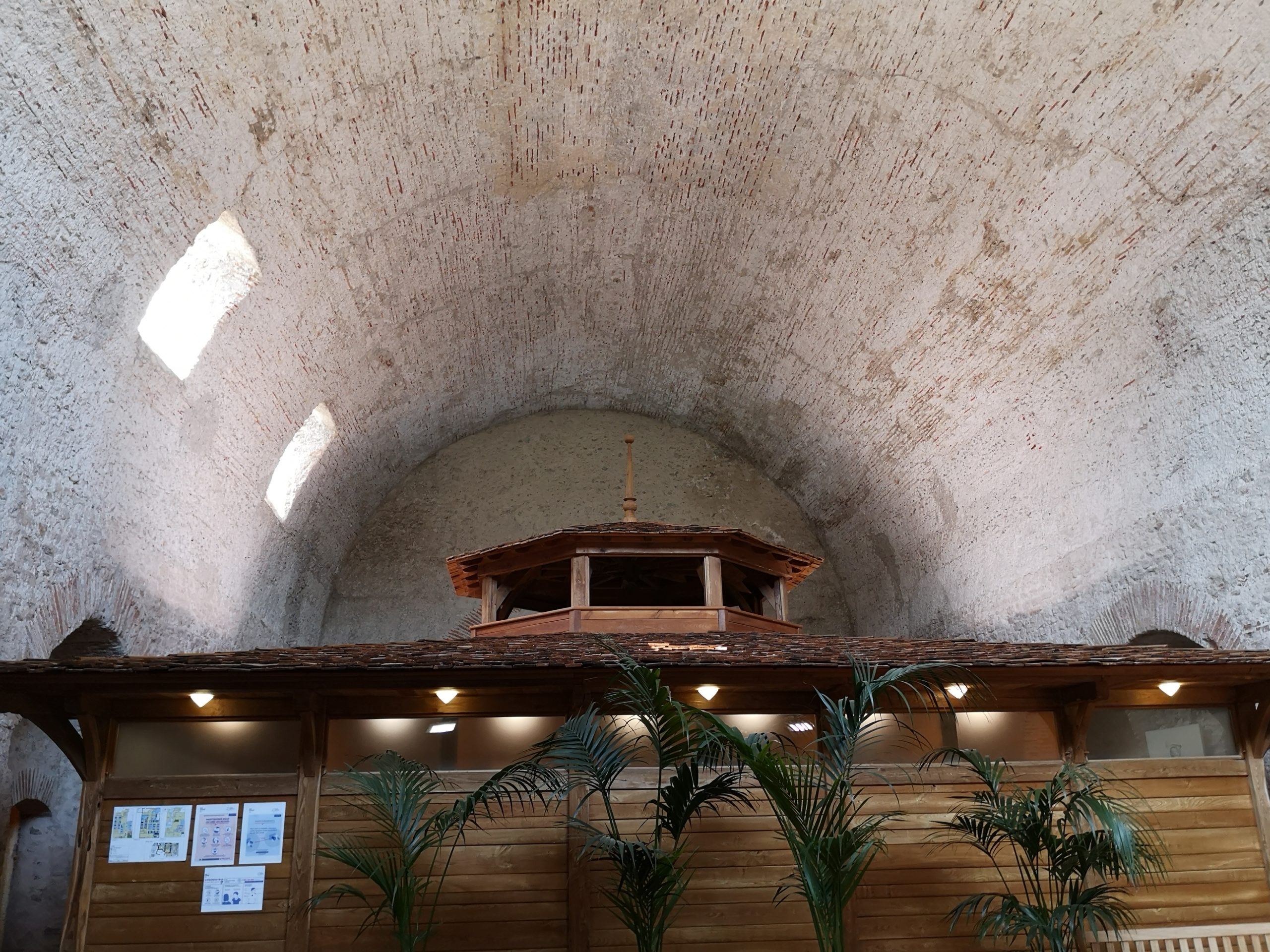Want to explore ocean views and stunning mountains in the south of France all in one trip? If you have time, head to Pyrénées-Orientales and start along the coast. Here, you’ll be graced with seaside resorts, stunning sandy beaches and rocky coves with breathtaking views. Renowned beaches include Canet-en-Roussillon, Saint-Cyprien, Argeles-sur-Mer and the beaches of Torreilles, which offer dunes, reeds and ponds. There’s also a traditional Catalan village at Sainte-Marie-la-Mer.
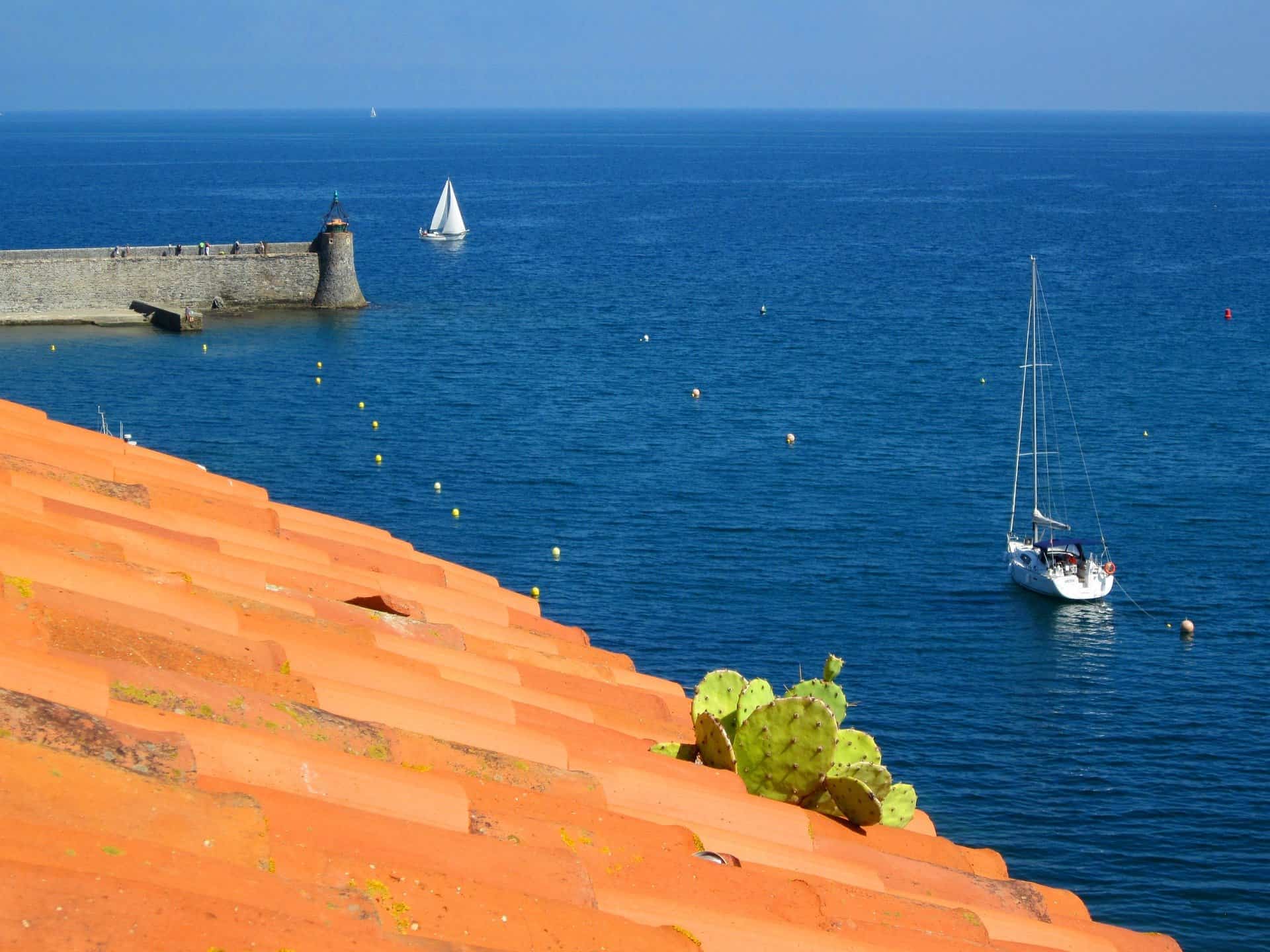
After relaxing in the midst of the coast’s salty air, nature lovers will want to head north to the mountains. The Pyrénées mountains that stretch across France‘s southern border with Spain are one of this nation’s most popular hot springs destinations thanks to the dozens of spas found here. After six years of sampling a wide range of these thermal bath stations with mixed success, we finally found the geothermic promised land during a two-week camping trip in the Pyrénées-Orientales department.
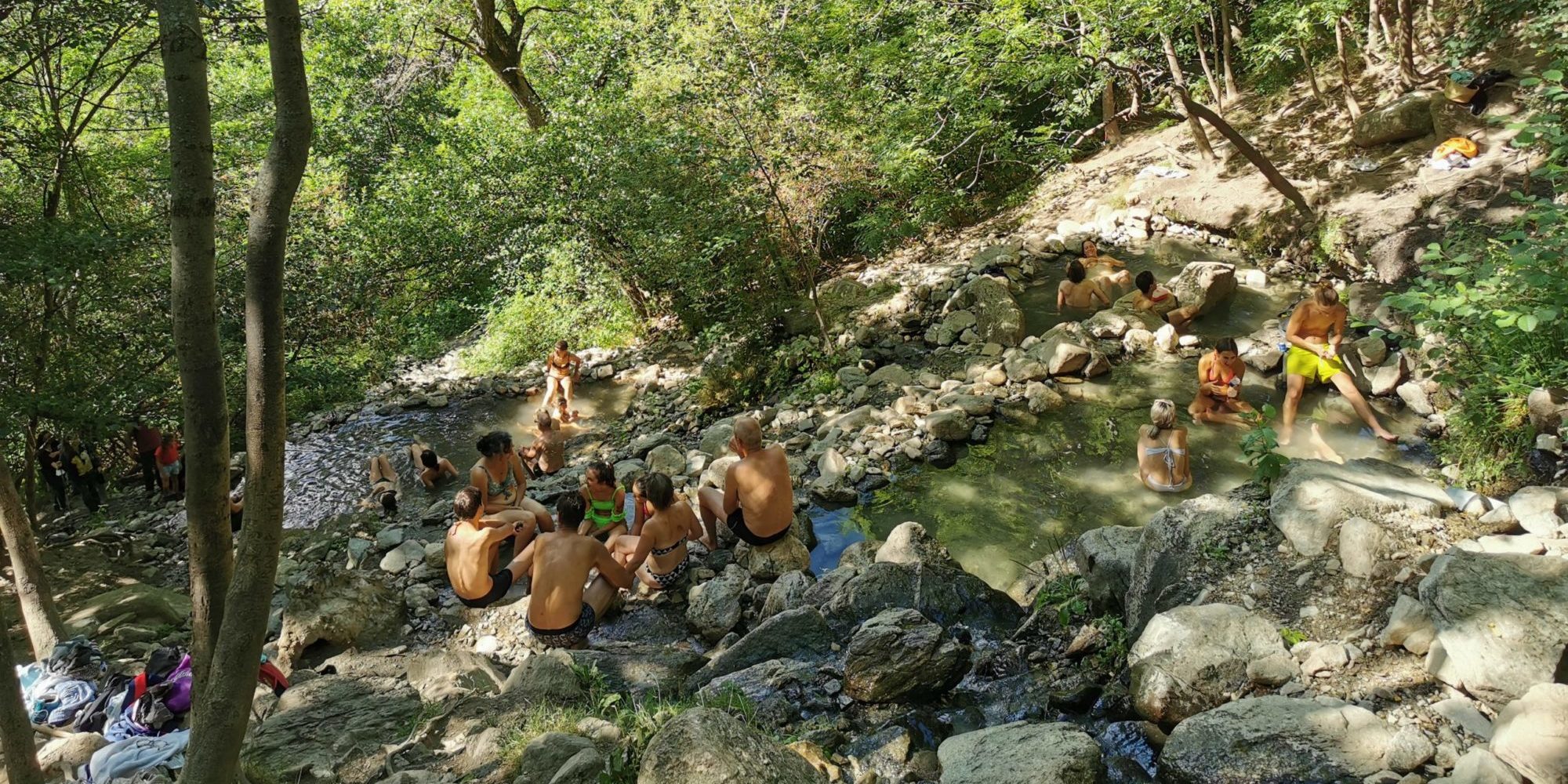
Natural hot springs of Prats-Balaguer in France’s Pyrénées-Orientales
We have visited numerous thermal bath stations across the Pyrénées since our family moved from the San Francisco Bay Area to Toulouse, France six years ago. But the experience has often been somewhat disappointing for a couple of reasons.
First, the French don’t like their hot springs too hot. Typically, the water is just a touch below body temperature. Not terrible, but always unsatisfying. At our favorite hot springs in California, there is a “hot pool” with water at 46 degrees celsius, and a warm pool around 38 degrees. Often, we find the water at French thermal stations to be around 34 degrees or 35 degrees.
That may seem like a small difference, but for us, it’s a yawning chasm in terms of the experience. Typically, we’ll be sitting in the water and thinking, “If they just nudged this up a couple of degrees…” Alas, no.
The other issue is that navigating the thermal station system is more complicated than one would think, though it’s for a good cause. In France, many of these thermal stations are essentially medical facilities. The country‘s health care system recognizes the health benefits of hot springs and will cover generous treatments for such ailments as arthritis that can last several weeks.
When researching a thermal station, one must ask if it’s for the “curists” or the “tourists.” If it’s for the former, you need a prescription. The websites for many of these places aren’t exactly clear on this point, since they all tend to talk about their “treatments” and their “well-being” plans. I typically have to call, and then I take the opportunity to ask about the water temperature. And then, more often than not, I sigh.
So heading to a new region and visiting its thermal stations involved a lot of research and phone calls. But the Pyrénées-Orientales offered another twist. It also is known to have several natural hot springs, places where the water emerges directly from the ground and people have built up rock enclosures to create improvised bathing experiences. The French refer to this as “eaux chaudes naturelles” or “bains chaudes sauvages.”
Whatever you call them, their locations are often referenced cryptically in various publications and blog posts. There appears to be an unspoken pact to not disclose too many details that would make them too easy to find, lest they become overrun by hordes of tourists. But the potential payoff was too tempting: The water is reportedly extremely hot. We were determined to find them.
Amélie-Les-Bains
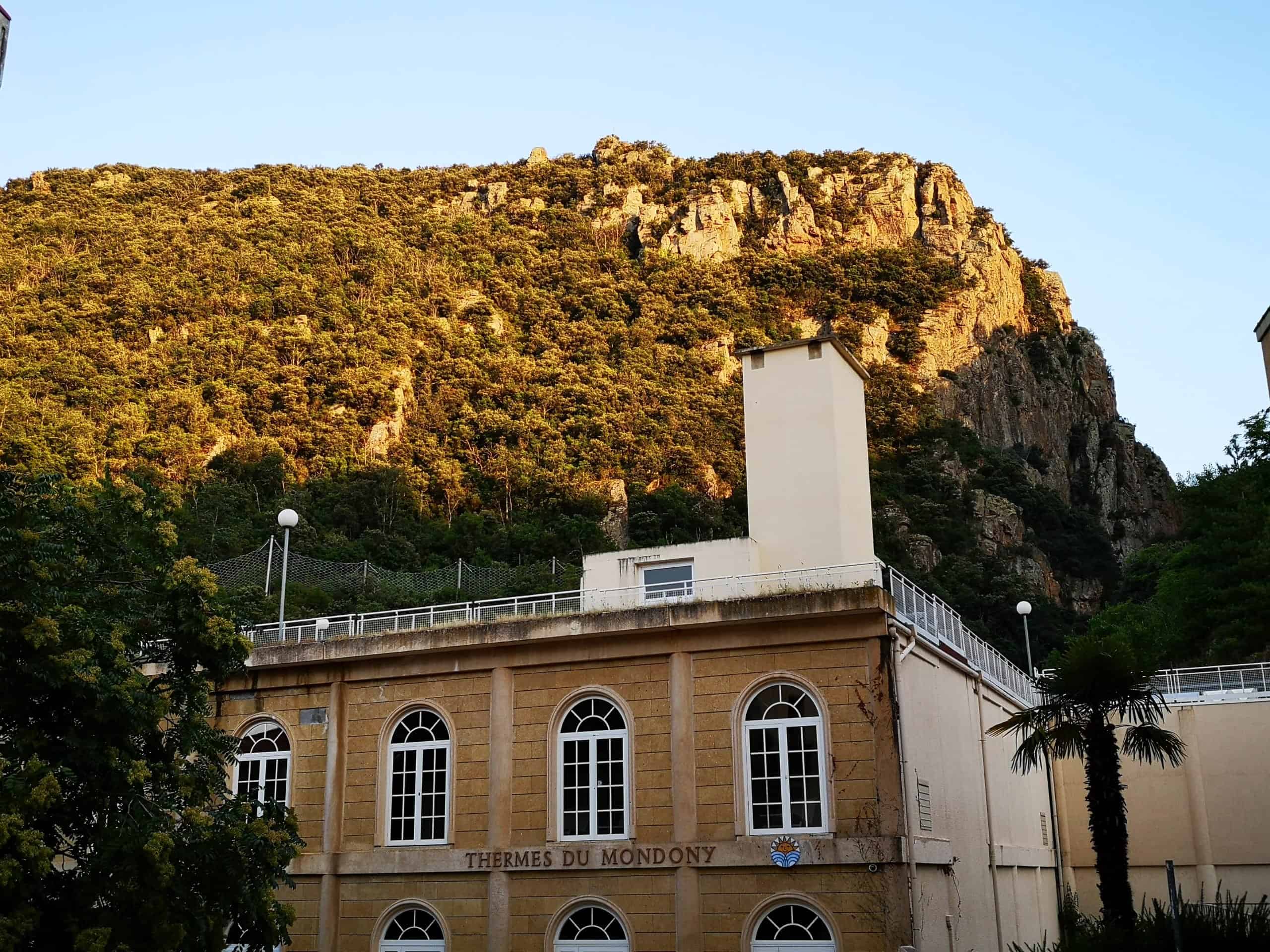
Pyrenées-Orientales is the French department located along the eastern part of the mountain range as it rises out of the Mediterranean and then soars 2,784 meters at the peak of Canigou Mountain. Once a part of Spain, it still proudly calls itself Pays Catalan with yellow and red flags of the Barcelona region as common here as France’s tricolor.
From our home in Toulouse, we followed the highway to the Mediterannean, turned south, and then west again to begin climbing up in the mountains. At this southern section of the department, the climb is gradual, winding through a few small towns before leading to Amélie-Les-Bains Palalda, the location of its namesake spa.
The town seems built around the baths, which offer services primarily for the curists, but also has some options for the tourists. My visit gave me just a taste of the facility as there were numerous limitations due to the pandemic, including the saunas being closed. As such, the €40 entrance fee was a bit steep by Pyrénées prices, but I had come too far not to test it out.
An employee led me inside to the changing area, and we walked in she pointed to the vaulting ceiling and noted that some of the structure dates back to the Roman empire.
After changing into my bathing suit, another employee led me into the bath which was horseshoe-shaped. Bathers entered for 10 minutes at a time, and so I waited for my turn. After showering, I descended into the water and was pleased to discover that it was slightly above body temperature. Each bather chooses a stall that has a series of jets blasting the back, legs, and shoulders.
As I enjoyed my warm-water message, an athletic young man walked to the stage at the center of the horseshoe and picked a styrofoam noodle and began leading many in our bathing shift in various exercises. I adopted out of the watercise, as I was more content to just chill, though there was no tuning out his exuberant instructions.
After my shift ended, I filed out to experience the next part of the visit: a mud bath. After showering again, I slipped slowly into the warm, bubbling white mud. This was my first mud bath and the sensation was a bit unnerving at first, but eventually relaxing as the mud reached my shoulders and my muscles seem to magically unclench. I could have stayed as long as I wanted, but 10 minutes left me completely limp and blissful.
And that was it. I showered, changed, and left. It was short, but the warmer-than-expected water left me feeling optimistic.
Les Bains de Llo
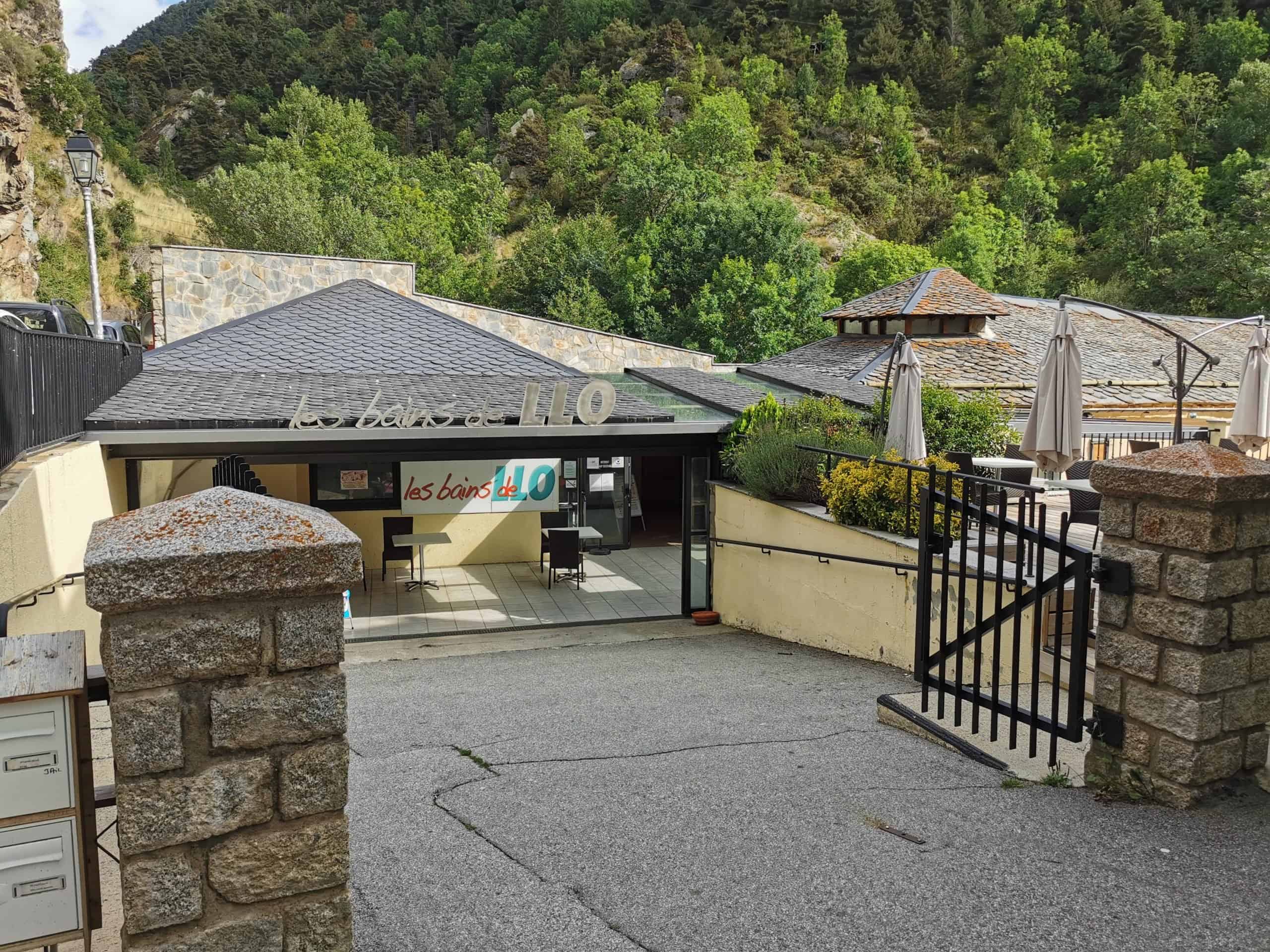
Les Bains de Llo
A few days later, we had relocated to another part of the department and a new campground. After a short hike, our family decided to treat ourselves to Les Bains de Llo. The €56 cost for two adults and teenagers was closer to what we’d typically pay in the Pyrénées.
Compared to some of the more fanciful thermal stations in the southwest of France, Llo is lowkey. The inside pool as a couple of fountains and water than again seemed a hair above body temperature. We then toured the series of outdoor pools, which include a large swimming area, and then a couple of smaller pools with intense jets. The water was a bit cooler out here, and so eventually we gravitated back inside to the warmer water where we staked out a corner and greedily defended it against all interlopers.
In all, we stayed out 90 minutes, the water temperature allowing a long bathing experience without getting overheated or dehydrated.

Les Bains de Llo
Prats-Balaguer Natural Hot Springs
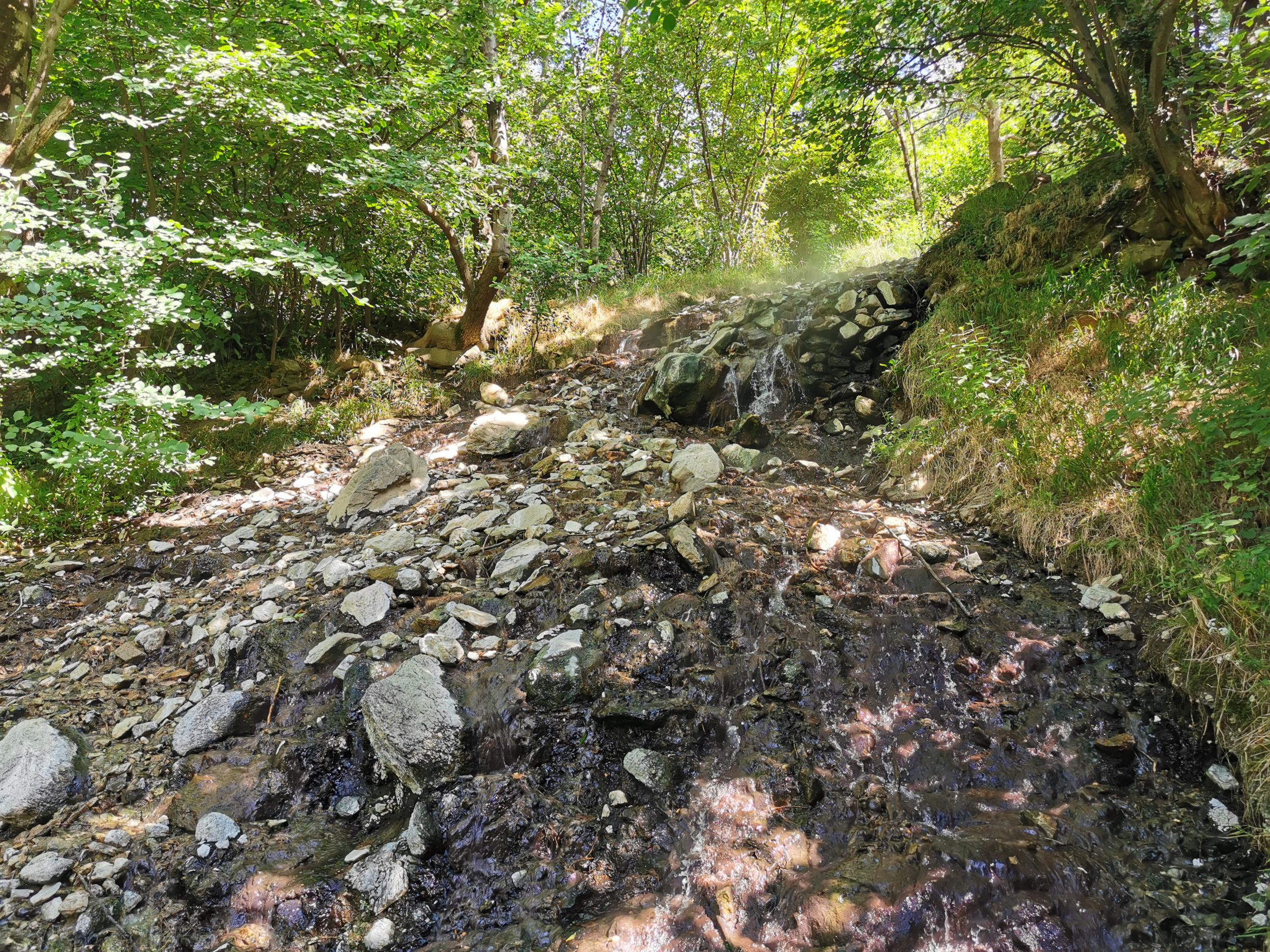
Having sampled two of the region’s more notable thermal stations. we were feeling more adventurous. So two days later we set out in search of the Prats-Balaguer Natural Hot Springs.
A description we had read promised that the springwater comes out of the ground at 70 degrees Celsius, and then trickles down a hill whether people have constructed 9 baths out of rocks over the years. This sounded dreamlike, but we only had the vaguest of directions for this treasure hunt.
We drove to the town of Fontpédrouse, and then turned off the main road and followed signs towards the village of Prats-Balaguer. The road eventually turned in a terrifying single-lane passage, winding around sheer walls of rock that offered no visibility around the bends. I drove as slowly as possible, honking madly as I made each turn while hoping that some crazed driver was not barrelling around the curve.
After 15 minutes, we arrived at a bend where a couple dozen cars were parked along the road leaving little doubt that we had reached the trailhead. We parked and walked further up the road until we saw a group of hippies gathered around their van. They point us to the trail which began with a steep scramble over rocks that took us almost straight down.
Our friendly guides turned out to be part of a mini-community that has set up a series of yurts and tents along the path and seemed to be living there. We followed the trail down, which was obvious in some places and less clear in others. This was not an official trail and so the usual signs and arrows were missing.
We still stopped a few times to check we were on the right path after crossing over a small stream and waterfall in the valley. Eventually, a faint smell of sulfur indicated we were almost there. And then, one last turn and saw thick steam rising out of the ground and a trickle of water running down a hill.
Below, that modest spring turned into a steady stream that we could see collecting in a series of descending rock pools. We couldn’t change fast enough. We dipped our toes in the highest pool, naturally the hottest, and then slipped in. The water was shallow, so we had to sit or lay down. But the temperature was well above 40 degrees Celsius. We felt as if after 6 years in France, we had finally found the hot springs Holy Grail.
At the temperature, we could only sit for about 10 minutes before moving down to the next pool, which was a bit deeper and cooler, probably just a hair under 40 degrees. We lazed there for a while and gazed at the verdant surroundings. We chuckled as other French families arrived, dipped their toes in the highest pool only to immediately recoil and shout, “Trop chaud!”
Most seemed content with the lowest pool, no doubt the coolest but we had no intention of moving from our spot. We had found the hot spring that we had fantasized about since leaving California and we lingered two hours before reluctantly leaving this little wonderland behind and walking back to the car.
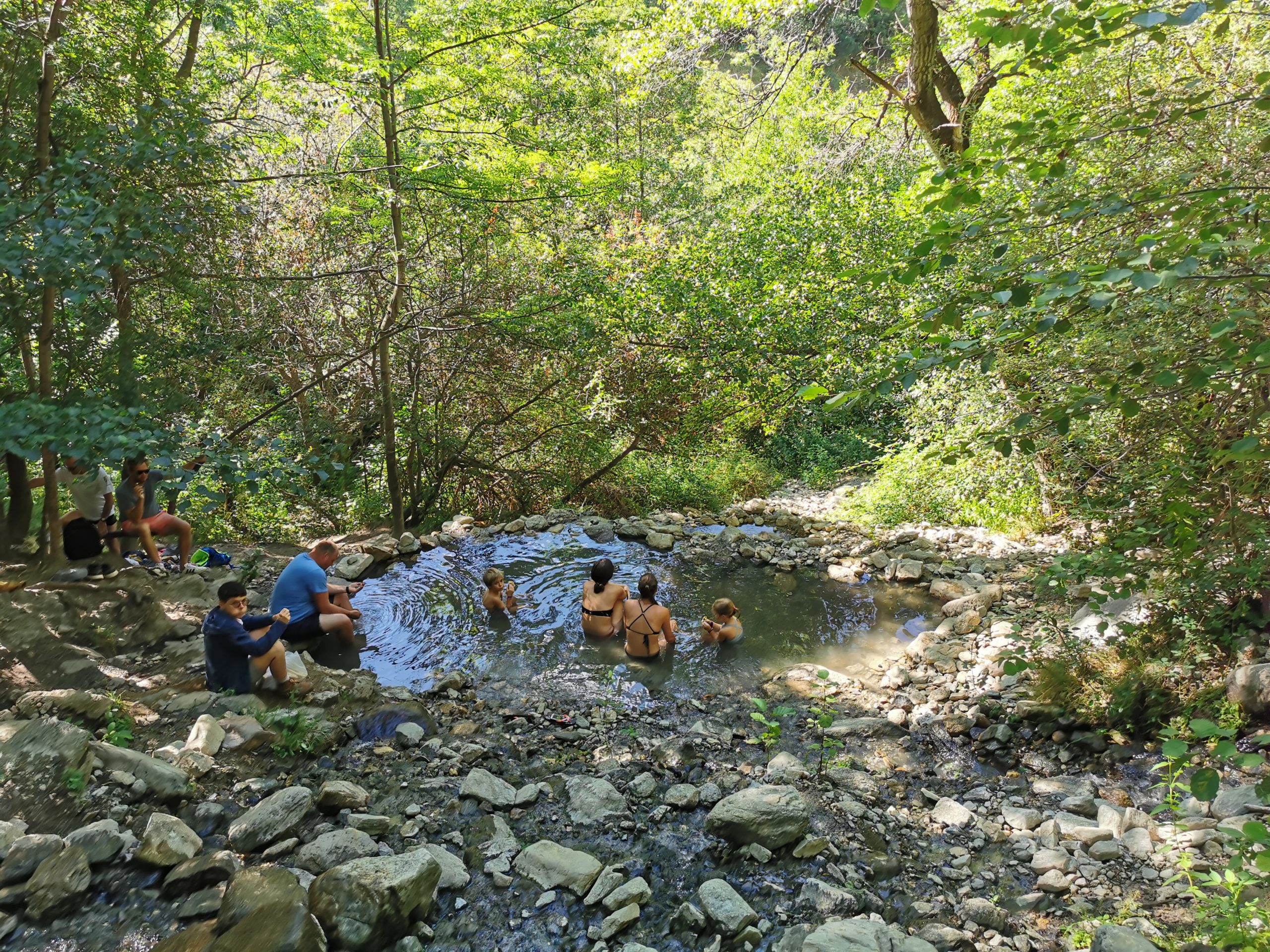
Saint-Thomas Thermal Baths
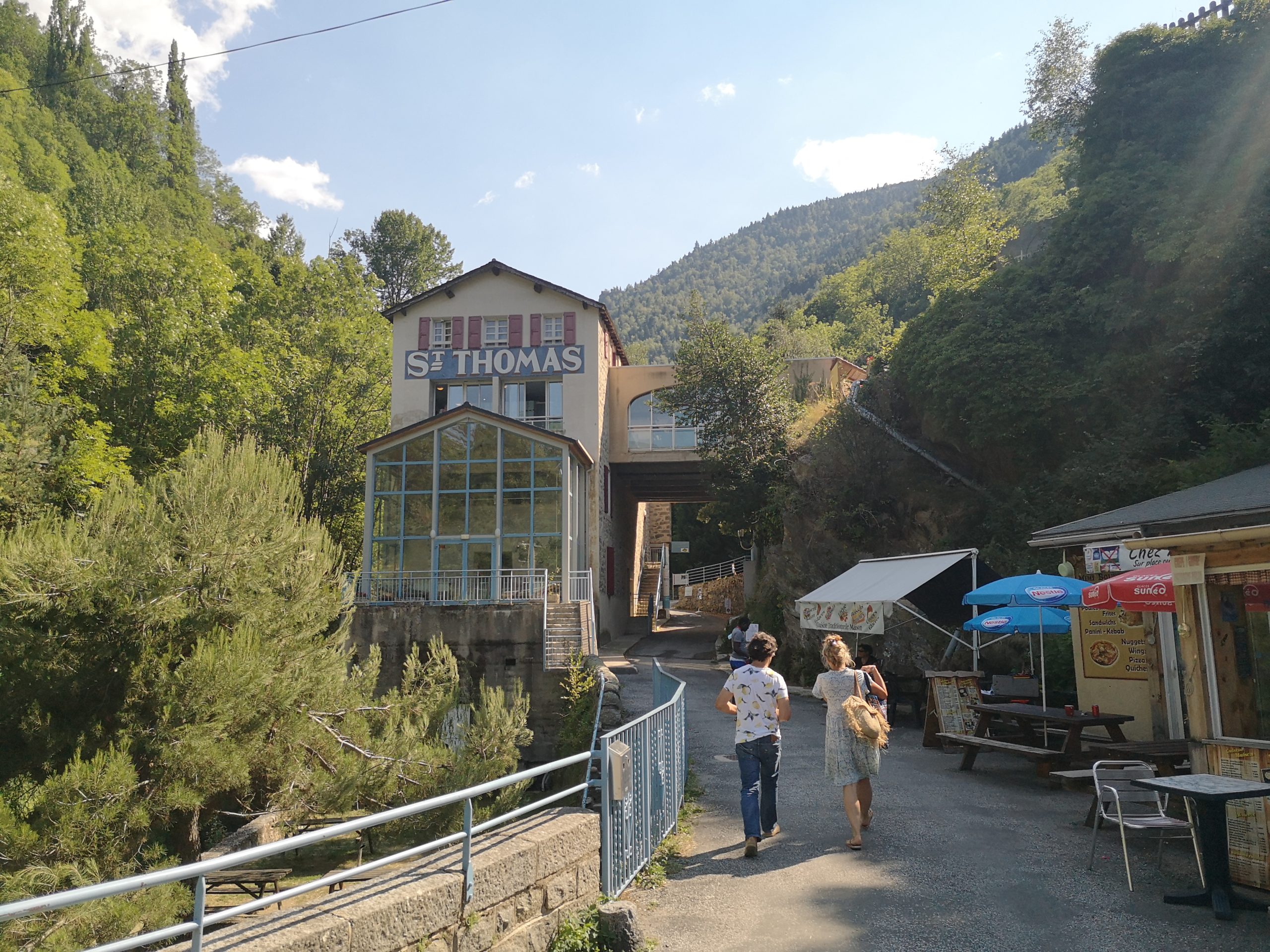
A few days later, we took a similar route to Fontpédrouse and then Prats-Balaguer, but then took a slight turn to arrive at a more classic thermal station, Les Bains de St. Thomas. This may have been one of the most modest hot springs we’ve visited in the Pyrénées in terms of its facilities, but that proved to be somewhat deceiving.
St. Thomas has just two baths of roughly the same size, plus a smaller wading pool, surrounded by an amphitheater for lounging and relaxing. The water again turned out to be surprisingly warm, about 38 degrees. There were no fancy amenities, just soothing water and a serene landscape surrounding the baths in a small valley.
Not only was our 90-minute soak peaceful and satisfying, but the €28 cost for four people made this the Pyrénées’ best thermal bath bargain.
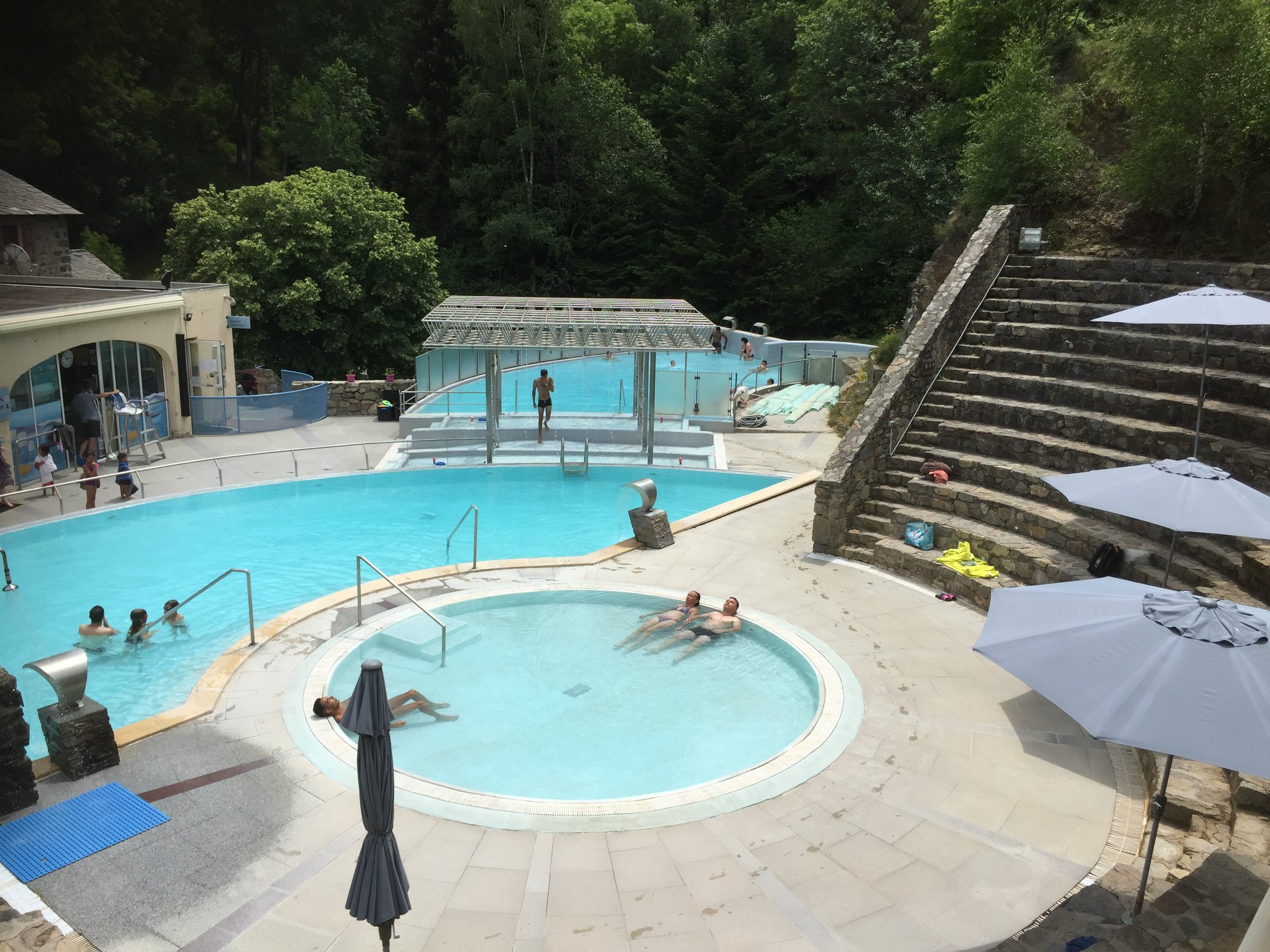
Photo courtesy of Saint-Thomas Thermal Baths
Canaveilles Natural Thermal Baths
With the memories of our first natural hot springs still fresh, we wanted to try one more before our vacation ended. The second one, however, proved far more challenging. And in fact, several weeks later, I’m not entirely sure we actually found the hot springs we had originally intended to discover.
Part of the confusion comes with the vagueness of the name. In some places, I’ve seen it called “Les Bains de Canaveilles.” And in other places it’s referred to as “Les 3 bassins sauvages des sources chaudes de Thuès.” Searching online under the first name, I found many references but little in the way of helpful directions.
But under the second name, I managed to find a map and directions on the French hiking app Visorando. Yet even these directions were confusing and hard to follow.
For this adventure, we took the region’s famous Yellow Train from Mont Louis to Villefranche-de-Conflent. We had to specifically request this since the train doesn’t necessarily stop at every station. We were the only ones who got off at Villefranche-de-Conflent, and just before the train pulled away, one of the employees said “Ah, you’re visiting the sources.” That seemed promising. At least we had come to the right place.
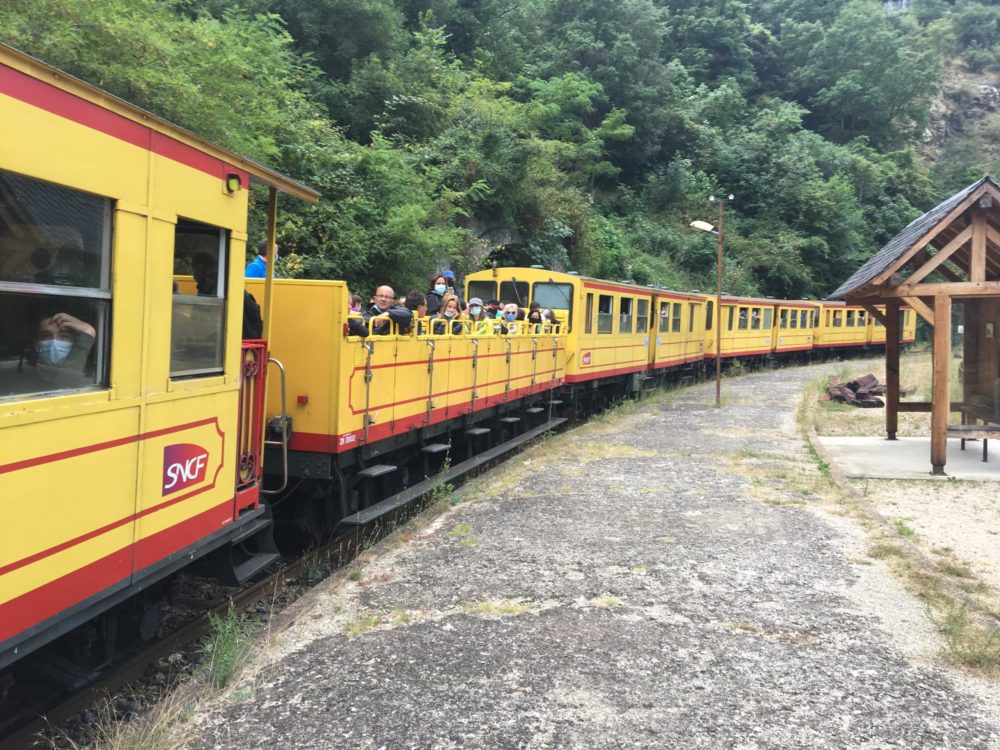
Pyrenees-Orientales Yellow Train stopping at Villefranche-de-Conflent.
From here, confusion reigned. The map and directions seemed to tell us to find a gate and a little path to lead us down from the small train station. We found a gate and walked about 5 minutes down a trail before crossing another family walking up. They insisted they had parked below and followed the trail up in search of the same hot springs and that it was further up the hill, not down.
Unsure of ourselves, we debated for a while and then backtracked to the station, crossed the tracks, and then hiked up a hill for 15 minutes. But something didn’t quite seem right, and after studying the map again, we doubled back to our original direction.
The directions said we should see an unmarked trail that split from the wider path we were following, and sure enough, we spotted one. It was only by pure luck that we saw it because this other path was barely noticeable, just a narrow stretch of dirt that one had to be looking for from just the right angle at just the right moment.
We gambled that this was the right path, but after a few minutes we began to see the series of pipes mentioned in the directions that take the hot springs water to the Thués thermal station below. The pipes were scalding hot, and so we had to climb over them gingerly.
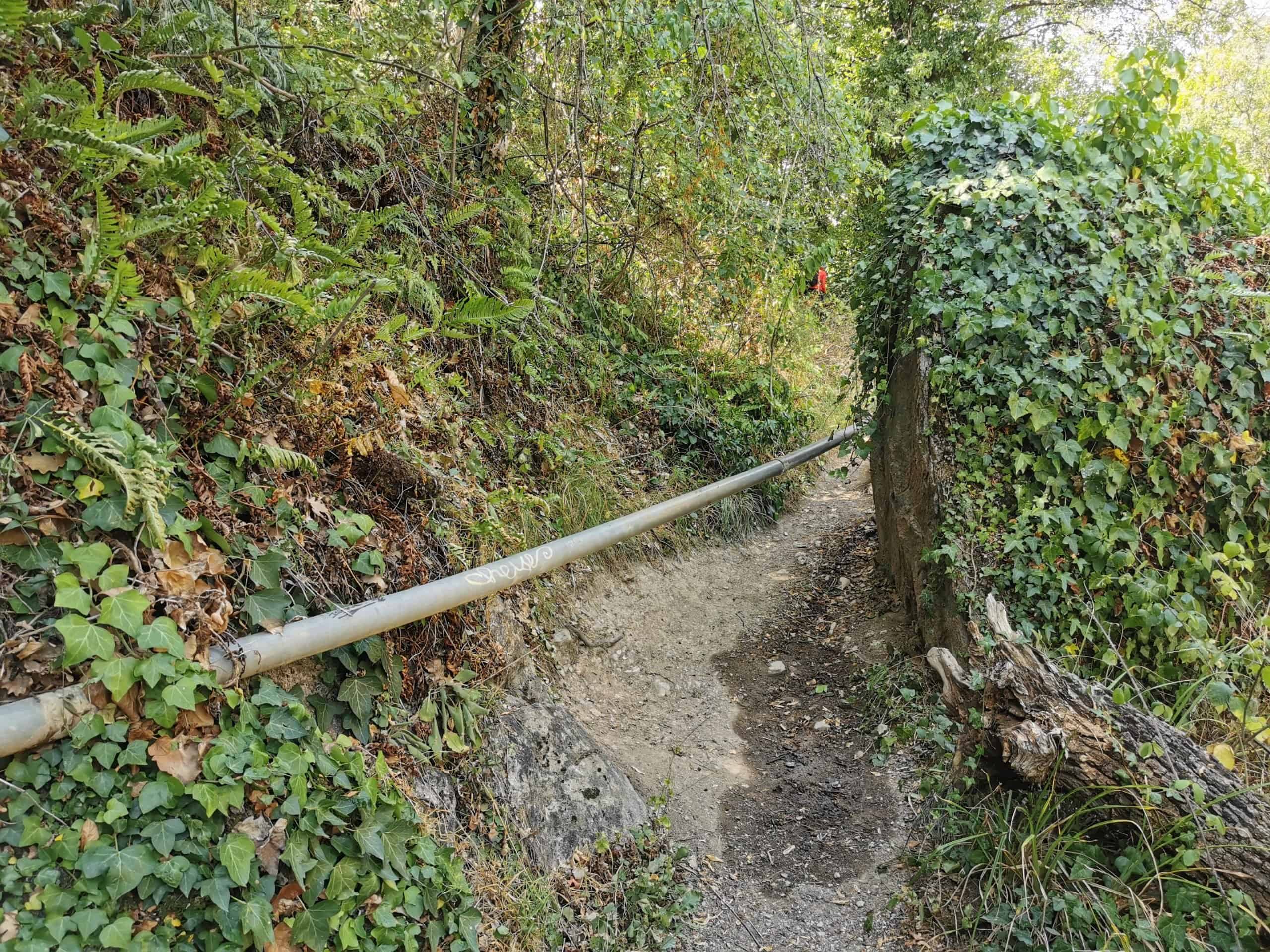
After another 15 minutes, the directions became confusing again. We reached a stream called Faget, but the path from here was unclear. Stumped, chose a path to follow the Faget upstream over terrain that seemed only to slightly to suggest an actual path.
Just as we were about to turn back, my wife spotted a trickle of water spilling over a large boulder to the left of the Faget and collecting in a rock pool below that someone had constructed. This little stream was blistering hot, but previously travelers had also built a little viaduct that diverted the cool water of the Faget into the rock pool where it mixed with the hot springs to create just the right temperature.
This hidden pool didn’t match any of the photos or descriptions of the hot springs we had set out to find. The map suggested these were further on, in a different direction. There was some mild temptation to search for them, but instead, we let that quest go in favor of just basking in this glorious, unexpected treasure.
After 2 hours, we packed up and said our goodbyes before hiking back out to wait for the train. It’s never easy leaving paradise. But now that we know the way to Shangri-La, we can go back any time.
_________________
Disclosure: The Pyrénées-Orientales Department of Tourism sponsored our trip by paying for our camping. The opinions expressed are entirely mine.
Chris O’Brien is an American journalist living in Toulouse, France. Before moving in 2014, he was based in Silicon Valley for 15 years, he wrote about technology and startups for the San Jose Mercury News and Los Angeles Times. From France, he publishes the twice-weekly newsletter French Crossroads which covers news and travel in France.

